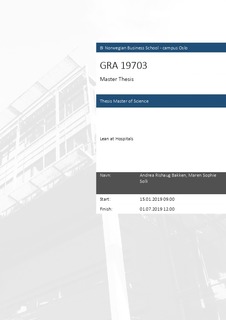Lean at Hospitals
Master thesis
Permanent lenke
http://hdl.handle.net/11250/2623585Utgivelsesdato
2019Metadata
Vis full innførselSamlinger
- Master of Science [1621]
Sammendrag
Hospitals are facing a huge paradox; although the system retain immense
competence, the business is not developing as expected (Lord, 2019). Medical
advancements have been remarkable, but more than 30% of allocated funds in the
healthcare sector are wasted by inefficiencies in the use of personnel, services,
equipment and processes (OECD, 2017). In addition, the scarcity of nurses has
become substantial across Norway and the current deficit of 5 600 nurses is
expected to increase to nearly 30 000 over the next sixteen years (Aftenposten,
2019). These challenges combined has prompted hospitals and governments to
search for solutions.
Lean is a modern mind-set that is claimed to increase quality, reduce costs and
bring a more acceptable workload. This philosophy has been put in use for more
than a decade at the first hospitals. However, research up until today is
inconclusive regarding both its applicability and output. Based on a literature
review of Lean, inventory management and supply chain management at hospitals
in combination with a comparative case study of two hospitals in the southeastern
region of Norway, this thesis examines “How can Lean contribute to improve
hospital supply chains?”
From a comprehensive analysis of the gathered data, the main findings are a
considerable number of hours spent on non-value adding activities, inadequate
inventory control and shortcomings in retaining a holistic view. While we have
identified several shortcomings at the two hospitals, there is no doubt that the
nurses and employees endure heroic efforts every day. Consequently, redesigning
the system is recommended. To a large extent, this entails an urgency of
enhancement in communication both internally at the hospitals and between the
various supply chain actors. In addition, it is suggested that Lean tools are
implemented in daily operations to release employees from being underutilized
and carrying out non-value adding activities. In general, the main step towards
Lean is to identify and eliminate the root causes - not just the symptoms. This
entails a mindset that focuses on problem-solving rather than fire-fighting.
Ultimately, value for the end customer, the patient, will increase.
Beskrivelse
Masteroppgave(MSc) in Master of Science in Business, Logistics, operations and supply chain management - Handelshøyskolen BI, 2019
